To Shoot a Thief
California salmon fishermen say if something isn't done about sea lions, the end of their industry may be in sight
By Ami Chen Mills
AT TEN PAST SIX in the morning, two salmon trollers follow the 26-foot Lady J, from their slips at Moss Landing into the open bay. Beneath a cottony gray sky, still waters near the harbor roll and glisten before yielding to Lady J's wake. The animated water looks like silk unfurling, silvery and molten, undulating in all directions. Alongside the craft low-flying pelicans skim its surface. Behind us, bathed in grainy, fog-light, the twin smoke stacks at the PG&E plant huff a column of smoke into the ashen sky.
Some fishermen on these small commercial vessels chugging cheerfully toward open waters say this season may be one of their last if things keep up the way they've been.
On a red buoy outside the harbor, some two dozen sea lions cluster, snoozing, sunning. To the land-legged observer, the sea lions are a delightful curiosity --their antics like child's play. To the men on boats forming a motley parade here, they are a malicious omen.
Some say sea lions will be the end of them.
Two weeks ago, south, in Morro Bay, a dozen sea lions on a buoy like this one were massacred in a shooting spree, probably by frustrated fishermen who saw an opportunity to get rid of a few more "fur bags." It was another casualty in an ongoing ocean battle fishermen believe squeamish landlubbers will never understand. Like conflicts over the hunting of the California mountain lion, a rise in protected sea lion populations, and ensuing encounters with fishermen at sea, threatens to pit animal-rights groups and land dwellers against those who live and work at sea. The California sea lion has become the salmon fisherman's mortal enemy in the hunt for a shared, and declining, ocean resource.
Shooting from the Ship
AFTER the well-publicized standoff with the U.S. Coast Guard a few weeks back, rebel salmon fisherman Jim Blaes told reporters the two guns he used were "for protection against sharks." Savvy marine types up and down the coast had a good laugh.
"At best, he's being very disingenuous," says Sean Van Sommeran, director of the Pelagic Shark Research Foundation in Santa Cruz, and a part-time commercial salmon fisherman himself. "Sharks don't menace fishermen, but they're soft targets because nobody likes 'em. Anyone with even a casual familiarity with this scene knows that weapons are used against sea lions."
Although Blaes denies ever having taken aim at a sea lion, many other salmon fishermen readily admit they shoot sea lions on sight, to kill, and take no prisoners.
"Oh, yeah, I've tried shooting 'em. I've maybe gotten about one or two," says "Buddy," 68, a salmon troller out of Fort Bragg, docked at Moss Landing to unload his catch and pick up a check. According to fishermen like Buddy, sea lions are the wickedest, wiliest creatures in the sea. "I'll just say that I hear a lot of banging out there on the ocean. Just being cute doesn't give you any more right to live than something that's ugly," he grumbles.
Of the estimated 170,000 sea lions along the West Coast, roughly 110,000 live on California's seaboard. Though adorable, they are not endangered. Protected by the 1972 Marine Mammal Protection Act which makes it a federal offense to harass or kill sea lions, populations are on the rise. Growth estimates range from 7 to 12 percent annually, and are fueled, in part, by easy salmon pickings off the lines of fishing boats. Squid fishermen are also plagued by sea lions, which get caught in their nets and must be released, unharmed, often with a portion of the catch.
Most of the fishermen who work out of Moss Landing, a harbor known for its tough, independent ways, are in their 50s and 60s, or are young Vietnamese. They sport stained baseball caps or Greek fishing caps encrusted with scales. They are sunburnt almost to the bone, fingers cracked and callused from handling moving line. These fishermen epitomize what may be a last generation of independent salmon fishermen. And it is here, in this anachronistic fishing port where their discontent swells and threatens to come to a head.
The Old Men And the Sea
THE Moss Landing Marine Supply shop smells of brewing coffee and rubber and is packed floor to ceiling with lead weights, lures, wood gaffs, silver flashers, yellow rain bibs, wading boots, rolls of line, fan belts, work gloves, and all things fishing. Hang at the front counter long enough, and somebody will start talking sea lions, the hot-button topic of the season. Voices will grow angry and thunder as each fisherman relays his latest and worst sea lion encounter.
Stories among salmon trollers run tall and wild. But there's no doubt that sea lions steal salmon directly and often from both commercial and sport fishermen's lines. How much they steal is a subject of controversy. Some fishermen claim that on a particularly bad day, 60 percent or more of their catch is lost to whiskered marauders. A 1995 short-term study by the Pacific States Marine Fisheries Commission places commercial salmon losses to sea lions in California at 12 percent of the total annual catch. Fishermen contend that sea lions memorize an engine signature, and harass that boat and its captain for weeks. Some say sea lions are teaching their young to catch fish the easy way, at a watery beggars' banquet where salmon thrash helplessly on fishing lines.
"There are days when I get three fish and the sea lions take 12," Buddy says. "They gang up on you. I'll tell you what's disgusting--I had a sea lion that stole two off my line and before he ate 'em, I got another fish. And he flipped his away and came after the one I just hooked! I think it's just a game for 'em. A cat-and-mouse game."
Highly adaptable, intelligent, and in the eyes of some, gleefully malicious, sea lions follow boats miles out to sea to steal salmon. "Some days we've quit in the morning 'cause the sea lions are so bad," Buddy complains. "If there's no control, they're gonna take over." The fishermen crowding the supply shop counter agree, with vehemence.
"I just spent the last five days battling sea lions off of Pigeon Point," says Tom McCray, a younger, sandy-blonde fisherman waiting to pay for a foam pad. McCray's been fishing the bay for 20 years, but says he's never seen sea lions this bad. "I ended up with a dozen salmon and lost a dozen. God, they're gettin' so aggressive--they came so close to the boat, you could smell their breath. It's obvious that five years from now there just won't be a fishery. This could terminate us."
John Favalora, a slight, mustachioed Italian whose family has been fishing for five generations, wears a T-shirt advertising a mock-Campbell's "Fisherman's Condemned Cream of Sea Lion Soup".
"In the first week of the season, I went out and got 17 fish on one tack and the fur bags got 16. We had to pick up the lines and run," grumbles Favalora, who says he hasn't carried a gun since his son accidentally shot and killed himself in 1964. A cousin of his, however, faces thousands in fines for shooting sea lions at random in the bay. "He wasn't doing the right thing. If they don't bother you, why bother them? It's just the ones that steal your fish," he explains.
"What we need to do is exterminate all of 'em!" yelps another fisherman waiting in line.
"Now that's the kind of talk that'll get us nowhere," cautions Russ Colwell from behind the counter. Colwell is shop owner and president of Fisherman's Alliance of Monterey Bay, a group petitioning Congress to transfer management of sea lions from federal authorities to the state Department of Fish and Game. Fish and Game, these fishermen believe, could regulate sea lions as it once did when fishermen were allowed to shoot sea lions to protect their catch before 1972.
Although no one's sure what natural sea lion levels are, the Alliance claims there's been an explosion in the sea lion population due to a lack of predation (grizzlies and coyotes used to snack on beached lions). Now, California sea lions threaten endangered salmon and compete for food with the endangered steller sea lion. Sea lions, these fishermen say, are contaminating shellfish beds with fecal matter, and threatening human life and safety. They pull out photos of salmon pulled from the San Lorenzo River, raked--or clawed--by sea lions, and graphs charting an inverse relationship between San Lorenzo salmon and sea lion populations. They say fishermen lose a rough average of 1.5 tons of salmon each to lions, or almost $3,000 a year in gross income. And the problem is getting worse.
Although funds to study the impact of sea lions have been scarce, preliminary studies and some marine enforcement officials are turning simpatico. A ten year sea-lion saga at the Ballard Dam in north Seattle has changed minds. There, persistent sea lions scooped up endangered salmon by the hundreds from special locks built for spawning, and returned to do it again despite the use of firecrackers, rubber arrows, long-distance relocation, mild harassment and even salmon laced with unpleasant flavors. Although the Humane Society of the United States sued to prevent it, the state got permission to shoot the lions. But before they did, a marine theme park picked them up.
If sea lions are a threat, they are one of a multitude of threats to the Pacific salmon stock and the beleaguered California salmon industry. Wild salmon are in dramatic decline along the California coast. Some at less than one percent of original numbers. Most salmon caught in the ocean are hatchery-raised. Some say sea lions are the least of fishermen's worries, but are scapegoated because they're visible and in direct confrontation with fishermen when they steal fish and tackle from trollers' lines.
Tending the Wounded
SALLY SMITH, spokeswoman for the Marine Mammal Center in Sausalito, says fishermen should take some responsibility for the current state of affairs. Although more fishermen are becoming environmentally conscious, she alleges they helped to create the sea lion problem by dumping chum into the water. "I have sympathy for people who have to make their boat payments. But by scapegoating these animals, we turn our backs to a much larger problem," she says, that of the overall ecological degradation of fishing waters along the California coast. She says that most sea mammals brought into the San Francisco Bay center test positive for carcinogens from agricultural runoff and ocean dumping. The sea is dying. Sea lions are a distraction.
Director of Animal Care Dawn Smith sees the worst casualties of the ongoing ocean battle against sea lions. The center accepts wounded and sick marine mammals found on 1,000 miles of California coastline, from Mendocino to San Luis Obispo. In a good year, Smith says she sees 40 to 50 shot sea lions. In a bad year, she sees up to 80. Those animals are the ones that make it to shore alive. Others die in the ocean and sink, or are washed up on beaches and picked apart by predators. For every one sea lion Smith treats, there may be dozens that never make it to her clinic.
When sea lions are shot, they often undergo weeks of agony before death. "Three weeks ago, we captured a bull at Moss Landing State Beach who had taken a bullet into his brain. By looking at the infection--even the bone had begun to rot--he'd been suffering with the bullet for two to three weeks, easily. And it still took 16 people to capture him. It's one thing if the lions are shot and killed. But I'd like for the fishermen to see what some of these animals go through."
Sea lions aren't the only marine mammals shot. Smith sees harbor seals, elephant seals and threatened steller sea lions with gunshot wounds as well. "I understand the frustrations fishermen face, and we can't lay all the blame at the feet of commercial fishermen," she says. Party boats and trigger-happy teenagers on shore do damage as well. But when it comes to shooting sea lions, fishermen--both commercial and sports--harbor a lion's share of the blame.
One Man Posse
FISHING has been called the last culture of hunter-gatherers. Nowhere in the industrialized world do humans continue to stalk wild game to feed the general population--a practice called "market hunting"--except in the ocean. Despite a growth in fish farming, and a downturn in wild fish stocks, independent, commercial fishermen continue to hunt the seas.
But increasing awareness of the ecological impacts of both over-fishing and land-based pollution has focused a regulatory spotlight on fishermen. They feel the brunt of increased regulations through shortened seasons and length requirements, equipment restrictions and catch limits.
To some extent, small fishermen pay for the actions of huge polluters and water-diversion projects upstream. Most fishermen want to protect salmon stock. They have self-taxed themselves to fund salmon habitat and support programs, and many are active in stream restoration and water-rights lobbying. But when it comes to protecting what they see as an overpopulated nuisance animal--think gophers or rats--enough is enough. "We fought hard to protect these fish," says fisherman McCray, "We deserve to make a living."
Working in the midst of unpopular regulations, public demands for environmental sensitivity and enraged fishermen are people like Roy Torres, special agent for the National Marine Fisheries Services. Torres is one of few enforcement agents charged with regulating an industry populated with gun-toting, ocean-going cowboys--and in a massive area with no cover, and as many entry points as there are miles of coastline.
"You're dealing with a very hot issue," says Torres, "I don't want it to seem like it's us against them. I get calls from fishermen who report shootings ... Let's just say fishermen don't always appreciate enforcement." Torres is the one man currently responsible for investigating violations of federal law for a seaboard that stretches from Half Moon Bay to Mexico, or 100,000 square miles of ocean and coastline--and then some. He is solely responsible for enforcing the Marine Mammal Protection Act, the Endangered Species Act, the Magnuson Fishery and Conservation Management Act, the National Marine Sanctuaries Act, and the Lacey Act governing international fisheries. That means that not only is Torres tracking sea lion and all other marine mammal harassment or killings, but large-scale, deep-sea drift-net fishing, illegal endangered-species trade, over-fishing of local waters, and all size, equipment, method and other regulations which govern the activities of the fishing industry in his region.
In his office in Pacific Grove, Torres answers phone calls, fills out forms, sends faxes and answers questions simultaneously. Since he took this job in September, there has been no time to hang the large sea maps and charts leaning against the walls.
From behind an in-box stacked a foot high, Torres estimates he gets about two calls per week on sea lion incidents. Today, he's got a message from Monterey Animal Control about a dead sea lion washed up on a beach in Carmel. Will he go down to check it out? "I usually just fill out a complaint request form. I don't have time to go out and look," he says matter-of-factly. Without an eyewitness, it'd be hard to make a case. Dead sea lions don't talk.
Torres is currently investigating an undercover endangered species case. He's also looking into a group of sport fishermen who admitted to shooting sea lions in the Salinas area, another case in which four sea lions were found dead along the Pajaro River, an over-fishing case in San Diego, and ongoing surveillance of fishermen at Moss Landing who may be taking more than their share of black cod from the bay. An elephant seal has washed up on Seabright Beach in Santa Cruz, and down south, a sea lion exploded after ingesting a seal bomb, an explosive designed to scare seals away from prime fishing locations.
In July, he flies to Alaska to assist the Canadian armed forces with an investigation into a high-seas "pirate fleet" suspected of dropping drift nets 30 miles wide. His nearest support staff keep offices in Santa Rosa. Otherwise, Torres operates with the crucial help of Fish and Game and the Coast Guard.
In 1995, 40 lion-shooting complaints were reported to the Santa Rosa NMFS office. As of this month, there have been 34 complaints for 1996, and counting. These do not include Southern California, which is temporarily part of Torres' stomping grounds. Since 1995, the NMFS has prosecuted two sea-lion shooting cases. "We're behind the ball," Torres says. "It can be demoralizing and discouraging, but you've just gotta keep plugging away."
Ever cheerful, Torres says he completes the tasks he commits to. The problem for him is time. "It probably takes three to four times longer than it should." In terms of sea lions and other, endangered species, Torres says, "The public has a general overall belief that wildlife is being protected. That's a misconception."
The NMFS Southwest Region, with an enforcement budget of $15 million, includes California and the Pacific Ocean from the California coast to Hawaii, Guam, American Samoa and outlying territories, a massive area.
NMFS officials say when they can make a sea lion case, they throw the book at violators. They do the best they can. But with this kind of backlog, the plight of a shot sea lion, given the population's increase, seems negligible.
Water World
ON the salmon boat, we chug past the outer buoys of Moss Landing, where the trollers fan out and chart their own courses to the rumored hot spot, Mulligan Hill. Five miles from shore, the PG&E stacks resemble tapered cigars puffing into the horizon. We slow up to set out lines. By now, most of the boats here know there's a lady reporter aboard the Lady J, the subject of jokes over the citizens band radio ever since we set out from the harbor.
Today the sea is quiet, except for the churning hum of boat engines. Fisherman Jack Trimble chain smokes between laying out lines and conferring with buddies on one of five CBs in his cabin. With salt-and-pepper stubble and the liquid eyes of a 65-year-old, Trimble, a commercial fisherman since 1968, still walks with a definite spring in his sneakered step.
Sea birds congregate above the bait below us which is marked by red blobs on the depth finder. "Don't like the looks of the water--too clear," Trimble complains, "But the birds are workin' it."
Eighty yards back, a sea lion bull glides lazily in and out of the water. When Trimble spots it, he groans, "Oh, don't tell me that." Like most salmon fishermen at Moss Landing, he keeps a log of lost catch for the Fisherman's Alliance. Out of 13 days he fished in May and June, he lost 39 salmon weighing between 10 and 30 pounds each, to sea lions. The worst day was May 14, when he lost nine fish. It's not just the fish, Trimble says, "But they'll take your hooks, your flashers, your what-have-you. And they'll stick with ya and take every fish you've got until you dump 'em off on someone else."
As we tack, the sea lion follows. "Now, that's not nice," Trimble grumbles. But at least there's only one. By now, most sea lions are on their way to the Channel Islands for breeding season. When they come back in late July, fishermen say, they're hungry. "I've had five or six following me at one time," Trimble says.
As he talks, his head swings left and right, he's eyeing the double springs on his outriggers for a "pupper," or strike. Suddenly, a bite's on, Trimble's at the lines in a shot, and within 10 minutes there are two King salmon flopping pitifully on deck. Trimble is yelling into a CB, "Up the Irish! Up the Irish!" Then, another pupper yanks the springs, but by the time Trimble pulls his line, his fish, his bait, his hook and his snap are gone. A hundred yards back, our sea lion rises triumphantly to the surface of the water with a huge salmon in its mouth. "That's my salmon," Trimble yells at no one in particular. Over the CB, another fisherman crackles, "I just lost a 25-pounder to a fur bag. Let me tell that lady on your boat how I feel!"
Before the day is done, Trimble will catch four salmon and lose two to sea lions--30 percent of his catch. It's been a slow morning. Other boats will lose more fish than they land. When the bulk of the lions return from the Channel Islands in July, some fishermen will pack it in. Sea lions help dictate salmon season now. And small salmon fishermen, who say they average roughly 25 grand a year, take the hit.
"There's another world out here and it's floating on the ocean," says fisherman Rich Hughett, "We grew up on the ocean and people who have never spent a day on the ocean are regulating us. We're the smallest part of this process," fisherman Bill Murtha adds. "We need help here."
Sea Lion Around
II'S early June at Monterey Harbor and nearly a thousand sea lions have beached themselves on the Coast Guard pier, piling on top of each other on breakers and on docks, nearly sinking a small boat with their weight. On the first day of the invasion, a huge bull circles the inner harbor, barking loudly, while mothers tend pups, piled all the way to the boat landing and the public restrooms in the parking lot. One bull circles in the water with a fishing diver trailing from his mouth. The stench from so many sea lion bodies hangs heavily in the air, but fails to keep tourists from approaching the horde to snap photos.
With funny little ears like fleshy apostrophes, a throaty canine bark, whiskered snouts and a lopsided gait, the animals are nothing if not cute. Near the boat dock, two women in white sweaters and low pumps are cooing. "Aren't they great?" one of them asks. "I think they're just darling," says the other, "Just like my dogs at home."
A harried SPCA official attempts to keep tourists away. The sea lions are dangerous: they can lunge and bite. They're protected as well. It's illegal to come within 50 feet of a marine mammal in the sanctuary. A fisherman runs over to tell Souza there's a sick pup on another dock. Souza grabs a net. Once caught, the lion begins to thrash and scream. Like other wounded or ill marine mammals, this animal will be taken to a secret holding pen in Moss Landing and then transferred to the Marine Mammal Center for nursing. When Souza nears his van with his catch, two tourists--women in bright, shiny jumpsuits and large sunglasses--come over to watch.
"Can you tell when a sea lion has been shot?" I ask Souza. The two women draw in their breaths. "Is that one shot?" asks one, alarmed. "Who would shoot a sea lion?" asks the other. "Oh, those guys who just want them for trophies," mutters the first with finality, and the two stroll off for lunch.
Like ranchers bothered by the protected California mountain lion, fishermen see tourists and animal lovers as naive. Saving an already dying sea lion is beyond their ken. "That's sickening," says fisherman McCray. "These are the same people who wouldn't give a damn about building a dam. ..." Even our beloved cats and dogs are neutered and put down to control populations, he notes. "Something stinks here," mutters McCray.
Sea Lions or Sacred Sea Cows?
JIM HARVEY, professor at Moss Landing Marine Labs -- one of a few marine biology outfits trying to be inconspicuous among the fishermen at Moss Landing -- predicts a dead-end for local fishermen organizing to change laws protecting lions. "There are too many people in the Midwest who don't care about salmon fishermen, they care about Flipper and sea lions. The public has this warped sense of what marine mammals are like."
But a time may come when fisheries are so threatened that management of sea lions is thrust into public debate. According to Brian Gorman, spokesman for the NMFS, the enforcement agency is aware that sea lions are a problem. "Right now you can't even look cross-eyed at a sea lion unless it's threatening your life. It's likely there will have to be some kind of change to the law."
A NMFS report commissioned by Congress in 1994--late, but expected in early 1997--may support fishermen's complaints about sea lions. Doyle Hanan, a Fish and Game marine biologist working on the report, says although research is sparse, sea lions may well be affecting the endangered salmon runs. "They certainly had an effect at the Ballard Locks," he says, where sea lions reportedly gobbled up 60 percent of the steelhead run. Hanan says sea lions normally eat smaller salmon, and small fish like sardines, not the massive, fast-moving salmon fishermen pull from the sea. And, he observes, when a fisherman baits 10 fish, but loses half to lions, ultimately, 10 fish must die for a catch of five.
The Marine Mammal Protection Act contains text allowing for the transfer of some mammal management to coastal states. Although California considered appealing for sea lion management in the mid-1980s, the effort was blocked by Governor George Deukmejian. Since then, the perceived strength of animal-rights and environmental groups, and public enthusiasm for marine mammals, has dissuaded further efforts.
The reluctance of the public and politicians to deal with sea lions gets state biologist Hanan's goat. Urban and suburban dwellers who go soft for cute or majestic animals, like sea and mountain lions, he says, don't realize that the biggest problem is not the fisherman, the hunter, or even the animal.
It's them.
Urban sprawl and pollution forces the decline of salmon and increases competition with sea lions. "People who are critical of the men who are catching fish don't realize that the foods they eat--whether vegetables, pork or beef--modifies and degrades the natural habitat," Hanan points out. Even vegetarians, he says, eat food for which land had to be plowed up, destroying natural habitat. Urban people gather their chicken in plucked, chilled pieces at the market, and are disconnected from the source of their food. "The salmon fishery is a renewable and diverse resource. Salmon fishermen are not destroying habitat," he says. "Fishing is environmentally compatible, as long as you're not over-fishing."
Some marine specialists say fishermen would be more effective if they targeted other problems like fish farming, deterioration of salmon habitat and the destruction of rivers. "The sea lion problem flares up mostly when the fish runs are poor," says Professor Harvey. "The perception [of sea lions as a problem] ends up changing from year to year. Quite a few fishermen don't really want to kill sea lions. They're just very emotionally tied to this whole thing."
Coho in the Coal Mine
SOME say protecting the livelihood of fishermen is a step toward protecting ourselves. They see salmon, their hunters and predators as aquatic canaries-in-the-coal-mine. "If our quality of life is important to us," says Gorman, "we ought to sit up and take notice when salmon themselves tell us, We cannot survive under these circumstances."
Just as hunters and environmentalists have common ground in protecting animal habitats on dry land, so, too, do fishers and environmentalists who have been facing off over whether or not to shoot marine mammals. "Sea lions cannot become the sacred cow," says Professor Harvey. "Both groups should be looking at aquatic habitats and rivers. That's where they could work as a united front. We all want to see lots and lots of fish out there."
Already, environmentalists from the Audubon Society and the Marine Mammal Center have teamed up with fishermen and fishing organizations to discuss working together. Even Jim Blaes supports regulations to protect endangered species like the winter-run Sacramento River Chinook, down to 1,360 fish in 1995.
Dawn Smith at the Marine Mammal Center says she and others cooperate with fishermen in an organization called the Near Shore Alliance, which funds sound fishing methods. Regarding sea lions, Smith says, "I'd like to see us sitting around the table and talking about these things." A colleague at the center has a lunch date with a fisherman who called to complain about their rehabilitation of a nuisance animal which just which happens to be cute. But is cute worth nothing? Ocean entrepreneurs rely on cute to draw tourist business, and tourists eat fish.
And fishermen, some say, have their own value, beyond economics and environmentalism. The existence of fishermen and their way of life is part of the west's heritage, and culture. Fishermen feed us, our national literature, our metaphors, our collective imaginations. They create a world we visit for hot clam chowder at lacquered wood tables overlooking harbors bustling with fishing boats.
"I'm from New England," says NMFS spokesman Gorman, and I have watched a magnificent fishery there destroyed--and with it, a way of life for fishermen whose fathers and grandfathers fished before them. Clearly there is something worth saving here that has nothing to do with money."
On the cool, windy docks of Moss Landing, fisherman Buddy grudgingly admits sea lions can be cute. "Yeah, the young ones are cute when they're out there playing. I like to watch them. But there has to be controls and balances."
Buddy knows drift-net fishing and environmental degradation are contributing to the decline of his lifestyle. And he knows of fishermen who have volunteered on stream restoration projects up north, although he hasn't done so himself. "I guess there are extremists on both sides who keep things riled up so we can't really get together."
As for Buddy, he plans to keep shooting at sea lions when he sees them, and keep on fishing, he says, "as long as the good Lord lets me."
[ Metro | Metroactive Central | Archives ]
This page was designed and created by the Boulevards team.
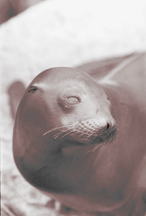
Moi? To landlubbing tourists, sea lions are the darlings of the ocean; to fishermen, they're wily, wicked salmon thieves.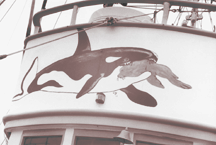

Cream 'Em: Fishermen like John Favalora have no love for sea lions.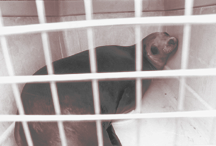
Caging Public Opinion : Sea lions suffering "natural" ailments are picked up and nursed back to health by the Marine Mammal Center in Sausalito, much to fishermen's dismay.
Secret Agent Man: Roy Torres, special agent for the National Marine Fisheries Service, sleuths sea-lion shootings and other infractions.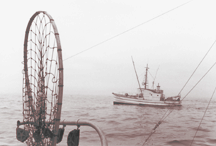
Netscape: Fishing boats out of Moss Landing harbor troll the waters at Mulligan Hill, hoping to land a few salmon while avoiding predation from sea lions.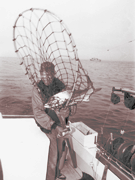
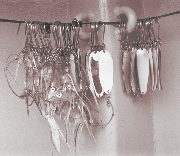
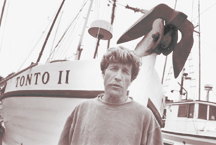
From the June 20-26, 1996 issue of Metro
Copyright © 1996 Metro Publishing and Virtual Valley, Inc.
